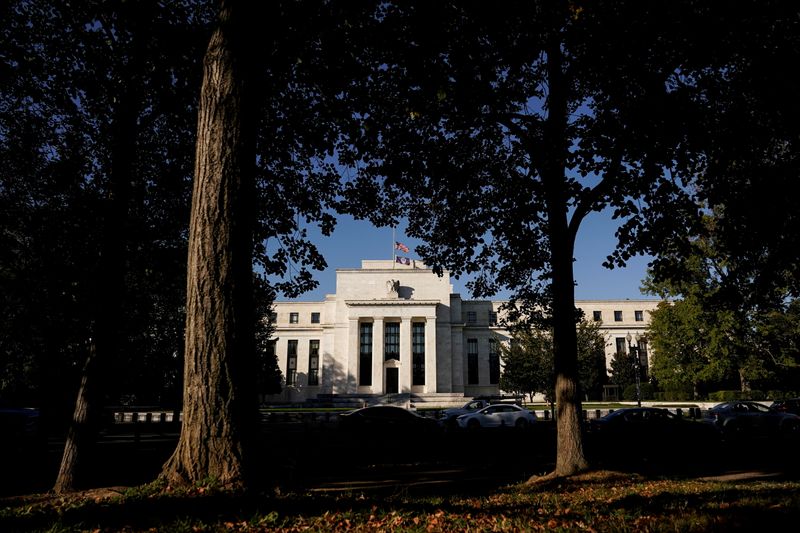By Jamie McGeever
ORLANDO, Fla. (Reuters) - U.S. interest rates are on a far steeper and faster climb than previously anticipated following the Federal Reserve's liftoff on Wednesday, bringing to an end zero-interest-rate policy, or "ZIRP," that has been mostly in place since the 2008 Great Financial Crisis.
Money markets are signaling that the Fed's surprisingly aggressive posture on inflation will put the brakes on the economy, forcing it to cut rates perhaps as early as the second half of next year, and definitely by 2024.
Traders are not pricing in recession though, at least not yet. Any reduction in the fed funds rate in the next couple of years would bring rates down to "neutral" from "restrictive" levels rather than signal a full-blown easing cycle.
At no point over the next three-to-five years does the Eurodollar curve show the Fed's benchmark rate falling below the 2.25% area. Before Wednesday's meeting and Fed Chair Jerome Powell's press conference, that floor was closer to 2.00%.
"No one wants to have to put restrictive monetary policy on in order to get inflation back down. Frankly, the need is one of getting rates back up to more neutral levels as quickly as we practicably can, and then moving beyond that if that turns out to be appropriate," Powell said.
But citing the new median forecasts that show the fed funds rate moving above longer-term neutral rate, Powell added: "And as you can see, it is appropriate."
2024 EURODOLLAR INVERSION
The Federal Reserve on Wednesday raised its fed funds target range by a quarter percentage point to 0.25%-0.50%, the first hike since 2018 and as expected. What surprised markets was just how far policymakers are prepared to go to choke off inflation.
New Fed projections showed a median interest rate of 1.9% this year and 2.8% for the next two years, significantly higher than the respective projections of 0.9%, 1.6% and 2.1% at December's policy meeting.
That's equal to seven quarter-point hikes this year, rising to at least 10 next year. The new "terminal" rate of 2.8% is also higher than the projected "neutral" rate of 2.4%, the level that neither runs the economy too hot nor too cold.
This prompted the Eurodollar curve to accelerate the hawkish repricing under way even before Russia's invasion of Ukraine three weeks ago put a fire under oil prices and inflation expectations.
The June 2023-December 2023 part of the curve inverted slightly again, indicating a slender chance of a rate cut in the second half of next year, but the bigger bets on a policy shift were set for 2024.
The first signs of this in the Eurodollar strip appeared on Feb. 10, two weeks before Russia invaded Ukraine, when various parts of the 2024 curve inverted. These bets intensified on Wednesday.
GOOD LUCK
The Eurodollar curve can be distorted by perceived credit risk and strong hedging demand from market players, so a premium is built into implied rates. But it is still considered a good guide to Fed expectations, so the flattening is noteworthy.
Yet it may not be flagging recession. Put another way, if traders think the economy will shrink in the next couple of years, they would surely be betting on more than 25 bps of rate cuts.
Granted, the Fed's room for maneuver will be more limited than before, with the exception of the last recession in 2020. That COVID-triggered slump in GDP was one of the steepest in U.S. history, but also the shortest.
The Fed slashed interest rates by 150 bps, brought back ZIRP, and launched a huge bond-buying program. With inflation as high as it is, no rate-cutting cycle is being reflected in money market pricing this time around. At least not yet.
Two reliable recession indicators give different signals: Plunging U.S. consumer confidence suggests recession is likely; but despite Wednesday's flattening the 2-year/10-year yield curve has not inverted yet, suggesting it is unlikely.
"Historically the Treasury yield curve inverts or is very close to inversion for several quarters ahead of a business cycle downturn. At present, we are just at rate lift-off at the Fed," SocGen's Stephen Gallagher wrote to clients.
But other observers, like Joe Lavorgna at Natixis, are skeptical the Fed can tighten financial conditions sufficiently to get inflation back down to its 2% target without hurting employment, demand and ultimately economic growth.
"I wish Jay Powell and company all the best of luck because they're not going to get anywhere near as they think, unless they're willing to throw a lot of people out of jobs, because that's what's going to happen. We're going to have a recession," Lavorgna said.
(The opinions expressed here are those of the author, a columnist for Reuters)
(By Jamie McGeever; Editing by Leslie Adler)
